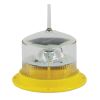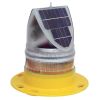Sealite SL-60 2-3NM+ Solar Marine Light
The Sealite SL-60 solar marine light features a 2-3 nautical mile visible range.
Features
- 4 user adjustable intensity settings
- 6 ultra high intensity LEDs
- 3 year fix or replace warranty
- Free ground shipping
- Expedited repair and warranty service
- Lifetime technical support
- More
Overview
The Sealite SL-60 is the most popular and versatile solar marine light available. Made from tough, durable polycarbonate and using the latest high-intensity LEDs, no expense has been spared in the design and development of this lantern. The SL-60 can be installed in minutes and requires no operator intervention. The Sl-60 comes with an environment-friendly bird deterrent built in to prevent damage to the device.
Adjustable
The user easily adjusts the flash sequences on site, and the lantern has a permanent ON/OFF switch for easy storage. The solar module will charge the battery during daylight hours, and the lantern will automatically begin operation at dusk.
Battery-Powered.
The SL-60 features a sealed battery compartment, allowing the battery to be replaced after years of service. Don't throw the light away at the end of the battery service life. Life expectancy of up to 12 years with battery replacement approximately every 5 years. The unit is sealed using polycarbonate bonding compounds similar to those used by major automobile manufacturing companies.
- Light Characteristics
- Light Source: 6 ultra-high intensity LEDs
- Range: 2 nautical miles
- Flash Color: Red, White, Yellow, Blue, Green
- Intensity:> 8.3cd
- Horizontal Output (degrees): 360 degrees
- Vertical Divergence: 9 degrees
- Flash Settings: Up to 256 IALA recommended (user adjustable)
- Lamp Life: 100,000 hours
- Electrical Characteristics
- Current Draw: Minimal
- Circuit Protection: Integrated
- Operating Voltage: 3.6v
- Autonomy:> 20 days (14 hour darkness, 12.5% duty cycle)
- Solar Module Type: Multicrystalline
- Output: 1.4watt
- Battery Type: High grade NiMH -replaceable
- Battery Capacity: 4Ah
- Battery Voltage: 3.6v
- Physical Characteristics
- Body Material: LEXAN Polycarbonate - UV stabilized
- Lens Material: LEXAN Polycarbonate - UV stabilized
- Mounting: 4x4.5mm mounting holes
- Height: 20.5cm
- Width: 17.7cm
- Mass: 1.1kg
- Certifications
- CE: EN61000-6-3:1997, EN61000-6-1:1997
- Quality Assurance: ISO9001:2000
- Waterproof: IP68
- Patents: US Pat. No. 6,667,582. AU Pat. No. 778,918
- Trademark: BargeSafe is a registered trademark of Sealite Pty Ltd
- Warranty: 3 years
In The News
From Hurricanes to Florida’s Red Tides: Monitoring the Southwest Gulf Coast
Nearly every year, southwest Florida is blighted by harmful Karenia brevis blooms–known colloquially as Florida red tides. These harmful algal blooms (HABs) form over the West Florida shelf and are pushed shorewards by winds and currents. Once in touching distance of the coast, they often intensify, fed by land-based runoff, anthropogenic nutrients, and decomposing marine life killed by toxins produced by these red tides. Red tides have become more severe and persistent over the past 20 years, causing major environmental and economic damage.
Read MoreWave-Powered Buoy Deployed in Puget Sound
While the development of solar-powered monitoring systems has improved access to real-time environmental data, solar power is still limited by low light conditions, such as poor weather, nighttime, or high-latitude environments. To supplement these incumbent power solutions at sea, Ocean Motion Technologies has developed a small-scale ocean wave energy system that can be directly integrated with existing data buoy platforms. Not only does wave energy supplement solar power during periods when the buoys are limited by light availability, but it also allows data buoys to perform beyond their current power capacities.
Read MoreLong-Term Monitoring in the Chautauqua Lake Watershed
With a widely developed shoreline, Chautauqua Lake experiences influxes of non-point source pollution that have historically impacted the health of the lake. The Chautauqua Lake Association (CLA) has been monitoring the lake for over two decades, reporting on changes that have occurred over the years. A pair of local lake advocates, Jane and Doug Conroe, have lived on the lake for over 40 years and have played an important role in establishing monitoring programs and facilitating consistent data collection throughout the watershed. Doug has been involved with the Chautauqua Lake Association (CLA) since the pair moved to the area in 1980, and is currently serving as the Executive Director.
Read More
















